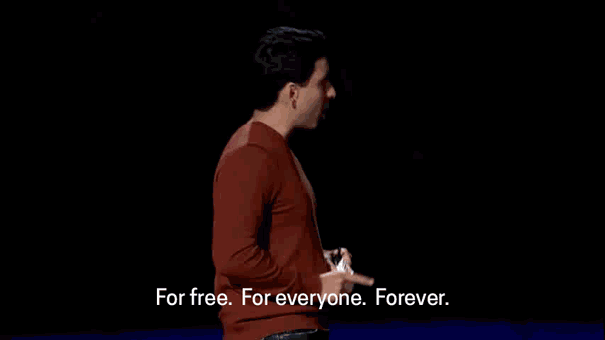Framing the Open Conversation – Branded Content & Fair Use
I recently presented research at the #et4online conference on the relationship between Open and what I refer to as branded digital content, a recent phenomenon in the proliferation of video-based learning resources where contents are available for users to watch without monetary transaction but lack a greater open utility (locked in a closed system, no remix/revise, a requirement to heavily advertise the creator of the contents). During my session, I noted an ironic situation in the debate around open materials: through the terms of § 107 (fair use), I felt more comfortable utilizing a clip from copyrighted Disney edutainment (the company largely behind proprietary copyright law as manifests today) than I did in clipping an aspect of a TED talk or a Khan Academy resource (two organizations marketing the freedom of their approach to knowledge and learning).
Why was it more comfortable to utilize closed and protected Disney media over what is heralded as open TED or Khan Academy media? While TED and Khan Academy celebrate the open display of their video contents (Khan famously notes For Free. For Everyone. Forever.), the Terms of Service for both TED and Khan Academy address the digital nature of such work and place rather severe restrictions on anything beyond broadcast. From Khan Academy’s Terms of Use:
Khan Academy grants to you a non-exclusive, non-transferable right to access and use the Licensed Educational Content as made available on the Website by Khan Academy solely for your personal, non-commercial purposes. Unless expressly indicated on the Website that a particular item of Licensed Educational Content is made available to Users under alternate license terms, you may not download, distribute, sell, lease, modify, or otherwise provide access to the Licensed Educational Content to any third party.
And from TED’s Terms of Use:
You cannot alter the videos in any way. This means you cannot edit, remix, cut, shorten, add overlays to them, or, well, alter them in any way.
This language is as blunt and specific as Disney’s website on licensing or receiving expressed written consent to utilize their intellectual property, but there is a precedent for fair use of archival contents (such as Disney media) in an educative purpose. Moreover, established repositories for thoughtful and scholarly media criticism such as the Critical Commons provide a semblance of cover for using very specific clips or sequences from a film/video text to illustrate a teaching moment. For example, if I embed a clip from Disney’s 1957 educational film Our Friend the Atom, its presence falls under fair use policy if I relate it to the scholarly conversation around the half-life of media contents and learning objects.
This clip is a prime example of how educational film, largely seen as neutral and objective in society, is subjective and politically charged and an example of salesmanship. The Truth of atomic energy as showcased here is faulty, right down to scientist Heinz Haber holding a block of uranium ore in his bare hand. Fair use allows me to isolate this clip for textual analysis in the context of my academic perspective.
The TOS for both TED and Khan Academy expressly forbid me to do the same. As these are not archival media but branded digital content their taxonomy and classification within the realm of archived media materials remains muddled. Thus, the Re-examining the Remix TEDx talk of Creative Commons and Fair Use crusader Larry Lessig cannot, according to the TOS for TED, be remixed, much less even clipped.
By itself, this clip is a celebration of remix and fair use. When put into the context of TED’s TOS, it becomes another example of the aphilosophical and atheoretical nature of these branded digital content providers (who represent a lot of the aims and ideas of EdTech at-large). The organization feels it is able to provide both localized contexts in their specific contents as well as the use of their contents on their page, but wrap their mission in very global, democratic and emancipatory language.
Wait, what? Did I just clip a TED talk?
Yes. Yes I did.
I have been troubled by the openwashing of organizations such as TED and Khan Academy, who extoll the virtues of their open content but have all elements other than viewership locked down in a draconian fashion. Making the point about the contradictions between the aims, marketing and localized folksy speech of these organizations requires an analysis of their media beyond watching on their site for the entire time of the clip. To that end, I spoke with my university’s reference librarian on matters of copyright and fair use, Kristen Hoffman, and she suggested we see if fair use is acceptable by working through the Fair Use checklist as created at Columbia University by Kenneth Crews and Dwayne Buttler. The checklist weighs fair use in terms of the material’s purpose, nature, amount and effect. For the instances I proposed in using TED content to illustrate TED’s aphilosophy and atheoretical approach, we found a short part of the Lessig speech that illustrated the point without taking the crux of Lessig’s original thesis (this is an example, not his entire statement). We found that in this instance, the checklist supported fair use on the strata of purpose, nature and amount, and was equal on both sides in terms of effect. With 13 elements favoring fair use and only 3 questioning fair use, we identified the localized purpose for the clip, added it to the Critical Commons, and incorporated it into this posting, a blog dedicated to furthering academic scholarship around theory and philosophy.
When a content provider heralds their work as open yet their TOS creates more fair use anxiety than Disney, there is a philosophical conundrum at the heart of what Open means. In this instance, the provisions of fair use in US copyright law and an organization such as the Critical Commons allow for a localized educative use of such a clip to illustrate the absurdity of TED’s position. And the ability to shine light on such fallacies through the incorporation of theoretical lenses is one way we can resist and negotiate the manner in which branded digital content providers define Open.



Here’s a thought experiment.
First, if I tell someone “go to this link (e.g. for a Ted talk) and watch it from 1:53 to 3:05” surely I’m not violating their terms, correct?
So, suppose instead I have a tool that understands the format of Ted talks, or Sal Khan lectures, and can link to the talk I’m interested in, and scrub forward to 1:53, then play the next 68 seconds and stop. I haven’t modified or remixed the Ted content, but I’ve provided easy access to a portion of it – and I can even have controls on it that say “show me the whole thing” or “let me go forward and back outside of the selected excerpt”. Does that violate their terms? I have in no way modified the content.
Now what if improve the tool so I can create a playlist of excerpts and cut virtually from one to the next?
Maybe someone has already figured this out….
Well said (as always).
Khan Academy uses the same term ‘modified’ as you do, so there is wiggle room there (as you mention, not modifying the content). But TED is explicit in saying you cannot cut or shorten the clip; you are trading the right to watch and download for the right to do anything with it other than watch and download. This makes it no different from watching PBS, except TED says it’s different.
As a former screenwriting teacher, I used to spend a lot of time putting together timecode references for my students: grab An Officer & A Gentleman (one of the best examples of Campbell’s narrative structure, oddly enough), go to the 18 minute mark, watch until 19:25. It was doable but a technical hassle, the sort of thing the ease and economy of technology is supposed to alleviate. This is where Fair Use becomes important; as a screenwriting teacher, if I am showing antagonism with Gunnery Sergeant Foley and this 90 second clip does it, I am providing a pedagogical tool without compromising the aims of the copyrighted film, so doing it through timecode or a digital clip is not important. When a company that sells itself on the opportunity for global and democratic access to free education explicitly states my inability to do the technological equivalent of timecoding, their use of the term ‘open’ is not germane with the OER definition or the general society definition. That makes me question the whole democratic and global thing. Personally, I think the democratic/global thing is the big lie on all parts, but it sticks in my craw more so when a group drapes themselves in it for their benefit without providing the same benefit to the learner.